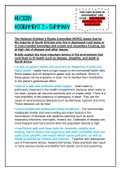Summary
HEC101V Assignment 2 AND summary for exam
- Course
- HEC101V - Health Education
- Institution
- University Of South Africa (Unisa)
This is an summary for the upcoming exam and the assignment answers. This module is a lot of work - I am busy making another summary. This will prepare you for the exam and your assignment 2. The summary is typed out according the question and answer method.
[Show more]













